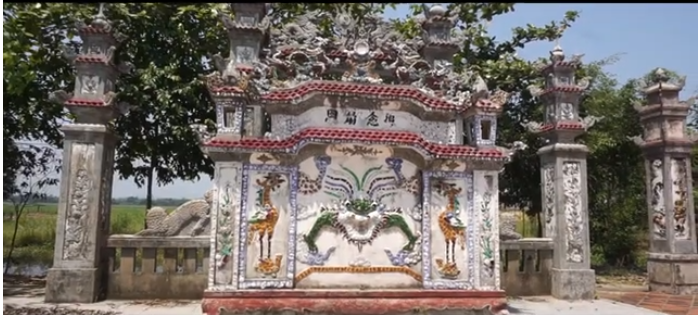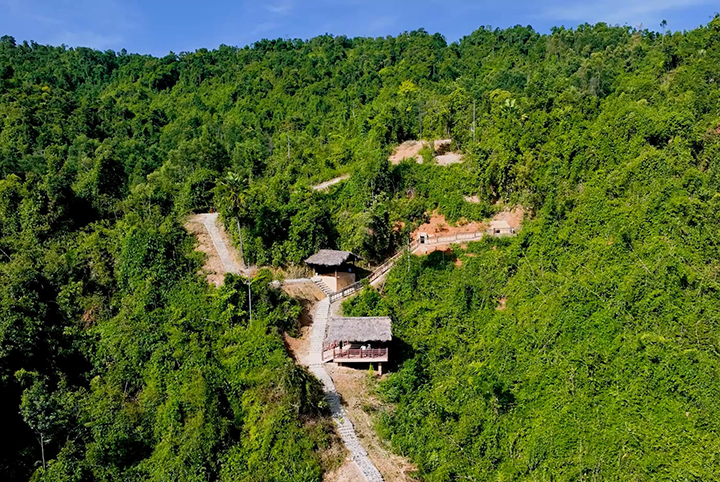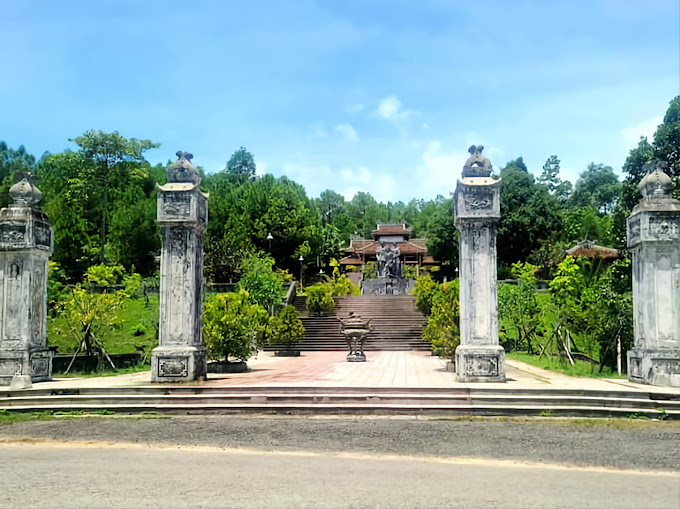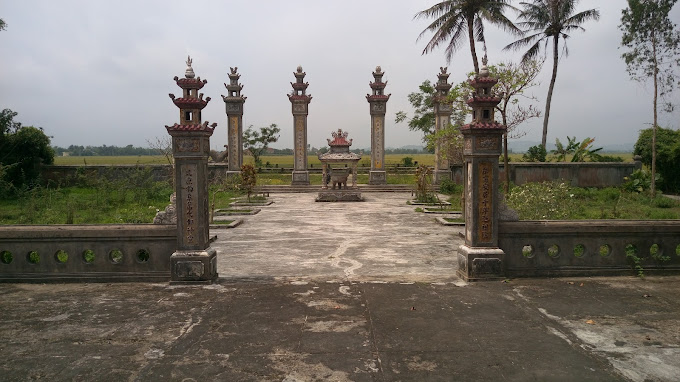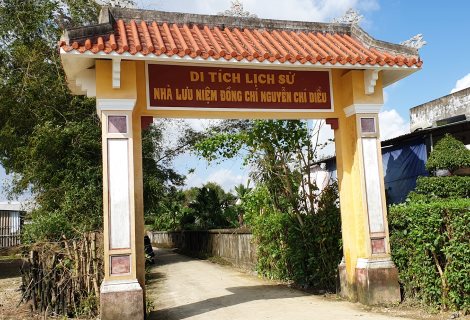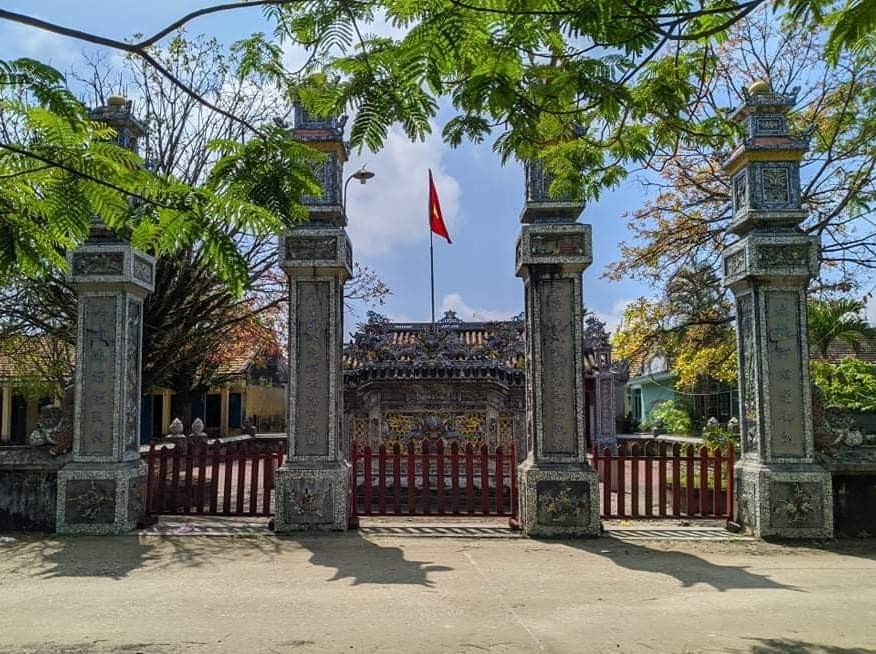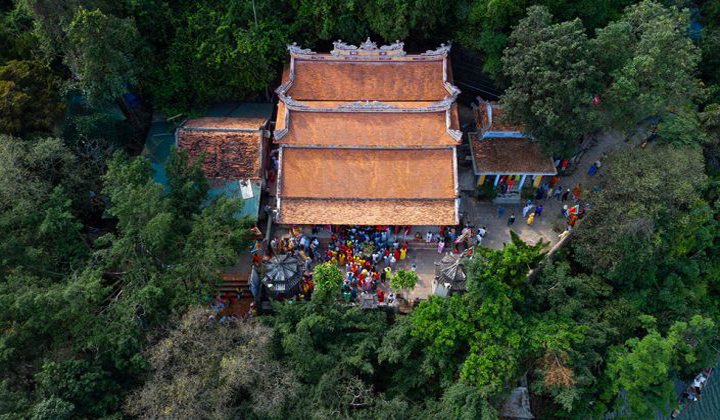Relic point Vietnam
Việt NamThanh Duyen Pagoda
Thanh Duyen Pagoda is an ancient site located on My Am Mountain (later changed to Thuy Hoa and then Thuy Van but locals often call it Tuy Van), Vinh Hien commune, Phu Loc district, close to the northern bank of Cau Hai lagoon, near Tu Hien estuary, built during the reign of Lord Nguyen Phuc Chu (1691 - 1725), in 1830 was upgraded by King Minh Mang, built a series of architectural works and named "Holy Duyen Tu". During the Nguyen Dynasty, this was a national pagoda, which the royal court took care of and restored and appointed famous monks to serve as monks and presiding officers. Thanh Duyen Pagoda is an ancient site located on My Am Mountain (later changed to Thuy Hoa and then Thuy Van but locals often call it Tuy Van), Vinh Hien commune, Phu Loc district, close to the northern bank of Cau Hai lagoon, near Tu Hien estuary, built during the reign of Lord Nguyen Phuc Chu (1691 - 1725), in 1830 was upgraded by King Minh Mang, built a series of architectural works and named "Holy Duyen Tu". During the Nguyen Dynasty, this was a national pagoda, which the royal court took care of and restored and sent famous monks to act as monks and preside over it. The beautiful scene of Thuy Van mountain with the Thanh Duyen Tu relic was ranked by King Thieu Tri as the ninth among the twenty beautiful scenes of Than Kinh land with the article "Van Son's beautiful relic" accompanied by a panoramic painting of the floating Thanh Duyen Pagoda. amidst the charming scenery of Thuy Van mountain, Cau Hai lagoon and the East Sea. Currently, through many restorations, Thanh Duyen Pagoda is gradually restoring the shape of the ancient pagoda with a communal house engraved with the poem "Van Son's Triumph" by King Thieu Tri built at the foot of the mountain, with a two-story pagoda gate and The main hall with 3 compartments and 2 wings also preserves bronze statues of the Three Buddhas, Avalokiteshvara, 18 Arhats, and ten Minh Vuong palaces. On the right side of the front yard of the pagoda, there is a stone stele engraved with 4 poems written by King Minh Mang about Thuy Hoa Mountain and Thanh Duyen Pagoda. In particular, in the middle of the main shrine is a bronze dragon throne with the words "The reigning Emperor Minh Mang has no reigns". Going gradually to the top of the mountain is the 2-storey Dai Tu Cac surrounded by a ceremonial gate and a citadel. On the top of the mountain is the 3-storey Dieu Ngu tower, about 15m high and Tien Sang communal house behind the tower overlooking the East Sea. Around the pagoda, there are still many ancient pine trees standing firmly over time. Source: Thua Thien Hue Electronic Information Portal.
Hue 2971 view
Giac Luong Pagoda
The location is in Hien Luong village, Phong Hien commune, Phong Dien district, Thua Thien Hue province, 21km northwest of Hue city center. Giac Luong Pagoda was built by Mrs. Hoang Thi Phieu and the patriarchs of the families in Hien Luong village during the reign of Le Trung Hung in Con Be, then moved to its current location. The pagoda is built facing south, rectangular in shape, 14.60m long, 11.48m wide, with a wooden roof, tiled roof, and includes 2 compartments and 4 wings. Next to the temple is the monk's house. The temple grounds are surrounded by rectangular walls, 79m long, 1.20m high, 0.50m thick. In front of the citadel, a pillar was built. The Tam Quan gate is massive, with an upper floor and three doors below, larger in scale than many national pagodas in Hue. In the pagoda, there are 7 Buddha statues, worshiping saints Quan Cong, Quan Binh, and Chau Xuong. The pagoda is descended from 12 ancestors of the families who publicly founded the Village. At the pagoda, there is still a large bell, cast in 1819, with the names of talented blacksmiths, mandarins and wealthy people who donated money to cast the bell and restore the pagoda. Giac Luong Pagoda contributes to the study of the history of the architectural style of Hue pagodas in the long mile of Vietnamese Buddhist architecture. Giac Luong Pagoda has been ranked as a national architectural and artistic relic according to Decision No. 776-Decision/Culture dated June 22, 1992 of the Ministry of Culture, Information and Sports (now the Ministry of Culture, Sports and Tourism). Sports and Tourism). Source: Thua Thien Hue Electronic Information Portal.
Hue 2860 view
Hoa Phong communal house
Hoa Phong communal house is located in Thuy Tan commune, Huong Thuy town, Thua Thien Hue province, 15km southeast of Hue city center, 3km from Phu Bai airport. The people of Hoa Phong have a tradition of patriotism, courage and resilience. During the two resistance wars against French colonialism and American imperialism, Hoa Phong people made many contributions to the revolution. Hoa Phong Communal House is the place to witness important historical events of the homeland during the revolutionary struggle. The village communal house is the place to organize many fundraising activities to support the resistance war such as "Bronze Week" and "Golden Week". For many years, Hoa Phong Communal House has been the workplace of Provincial Party Committee leaders such as comrade Tu Minh, comrade Ha (Len), comrades Nguyen Hung, Hoang Lanh, Hoang Dac, Le Trong Bat... Especially In March 1947, comrade Nguyen Chi Thanh - Secretary of the Binh Tri Thien Party Committee held a meeting at Hoa Phong Communal House and identified Hoa Phong as a hidden base of the revolution, a contact point, within the system. lobby supply between the plain and the war zone. The people of Hoa Phong made many contributions to the resistance war against the US to save the country and Hoa Phong Communal House is the contact address between Huong Thuy district (now Huong Thuy town) and communes in the district. Hoa Phong communal house relic has been recognized by the State as a national revolutionary historical relic according to Decision No. 1460/Quyet Dinh -Van Hoa, dated June 28, 1996. Source: Thua Thien Hue Electronic Information Portal.
Hue 3681 view
Tunnels of Tri Thien Hue Party Committee
Tri Thien Hue Party Committee Tunnels are located in the Khe Trai area, Huong Van ward, Huong Tra town, Thua Thien Hue province, about 25 km northwest of Hue city. During the resistance war against the US to save the country, the Tri Thien battlefield in general and Thua Thien Hue in particular were always hot spots. In mid-1967, our position and strength on the battlefield developed strongly. Grasping the opportunity, the Thua Thien Hue Provincial Party Committee advocates directing localities in the province, especially Hue city, to break the grip and develop revolutionary bases in the enemy's heart to create conditions for military and political activities. expanding the liberated area, gradually strengthening the direction of building revolutionary bases in adjacent areas and the tunnels of the Tri Thien Hue Party Committee were born in that situation. In August 1967, the tunnel began construction under the direct direction of comrade Tu Minh - Deputy Secretary of the Regional Party Committee, Secretary of the Hue City Party Committee, commanding the front, and comrade Dang Kinh - Deputy Commander of the military region. Standing member of the Regional Party Committee. The main force is the police protection team. The tunnel is the headquarters of the Tri Thien Party Committee, the Hue City Party Committee, directing all activities of the liberation army forces before and after the spring attack in 1968. In addition to its responsibility as the supreme command body in battle, Tri Thien Hue School, is also a bridge connecting the strategic intentions of the Party Central Committee and the Ministry of National Defense. At the tunnels, many important meetings took place to reach the right decisions, greatly contributing to the success of the Spring 68 campaign in Thua Thien Hue, along with victories on the battlefield. fatally forced the US imperialists and their lackeys to sit at the negotiating table in Paris. The historic victory of the Mau Than spring of 1968 delighted the country's compatriots and international friends, with the worthy contributions of the heroic Tri Thien Hue army and people. With the noble title awarded by the Party and State: "Attack, uprising, heroic, resilient". The tunnels of the Tri Thien Party Committee are eloquent evidence of strength, the people's war posture is a high-level promotion of the strength of three types of troops, in all three strategic regions, enriching the treasure of military theory. Vietnam, the art of people's war of our army. The war has passed but those valuable lessons are still valid... The Tri Thien Hue Party Committee Zone Tunnel Relic was recognized by the Ministry of Culture and Information as a national historical relic in Decision No. 310-Quyet/Ministry of Culture and Sports dated February 13, 1996. With tradition , the nation's ethic of drinking water, remembering its source, the tunnels of the Party Committee were invested in by the State to restore and renovate to be worthy of the historical value and stature of a national monument, becoming an attractive tourist destination. guide, serve domestic and international visitors. Source: Thua Thien Hue Electronic Information Portal.
Hue 2665 view
Nine Tunnels Historical Relic Area
Chin Ham relic site is located on the slopes of Thien Thai mountain, in Ngu Tay village, Thuy An commune (now An Tay ward), Hue city. The former Nine Ham Area (1941) was built by the French colonialists as a weapons warehouse. In 1945, after the Japanese coup d'etat over France (March 9, 1945), the Japanese fascists took all the weapons here, the Chin Ham area was left vacant. Under the Ngo Dinh Diem government, Ngo Dinh Can, as "Lord of the Central Region", converted Chin Ham into a place to imprison revolutionary soldiers and patriots. From here, Chin Ham Prison is associated with the barbaric crimes that the Ngo family committed against our people. These tunnels were converted by Ngo Dinh Can into semi-submerged, semi-floating rectangular concrete blocks. Among these, dungeon number 7 is a typical dungeon system. Can had them converted into tiger cage-style cells that could only fit one person (1.8m x 1.8m x 1.8m), under the hands of tyrant Ngo Dinh Can, using no means to subdued the revolutionary will and patriotic spirit of the soldiers. Their crimes are encapsulated in more than three thousand verses in the poetry collection "Living in the Grave" by author Nguyen Dan Trung (Nguyen Minh Van), a witness who survived from Nine Ham Prison, the real poetry collection. is a denunciation of the crimes of the Ngo family group, touching many people. It is a tribute to the loyal communist soldiers who devoted their lives to the Party, to the people, and to the cause of national liberation. A shining example for everyone to study. To commemorate the communist soldiers and patriots who fell at Chin Ham, and also to mark the crimes of the enemy, on December 16, 1993, the Ministry of Culture and Sports issued Decision No. 2015 -Decision/Ministry of Culture, Sports and Tourism recognizing Chin Ham relic as a national historical and cultural relic. Source: Thua Thien Hue Electronic Information Portal.
Hue 3137 view
Van The Village Communal House
Location: About 9km southeast of Hue city center, Van The communal house is located in Thuy Thanh commune, Huong Thuy town, Thua Thien Hue province. Located in the center of the village on an area of 7 acres, behind is the Nhu Y canal (which King Gia Long dug in 1806) facing the endless Truong Son range. Just as ordinary and simple as many other communal houses in Vietnamese villages, Van The village communal house is a sacred place, a gathering place to express the wishes, determination, and solidarity of the people of hundreds of families, in the face of challenges. An important event of the homeland and the country, at the same time, it is also the place to best preserve and preserve traditions and national cultural identity, despite the cultural pressures introduced from outside. With a heroic past, especially during the two resistance wars against the French colonialists and the American imperialists, Van The communal house has become the revolutionary cradle of Huong Thuy district, a historical place of the province. Currently, the monument has invested in restoring and repairing a number of items, so that the monument is increasingly perfect. Van The communal house historical relic has been recognized as a national relic by Decision No. 985/Quyet Dinh-Van Hoa dated May 7, 1997. Source: Thua Thien Hue Electronic Information Portal.
Hue 3128 view
Comrade Nguyen Chi Dieu Memorial House
Comrade Nguyen Chi Dieu (1908-1939) was from Thanh Tien village, Phu Mau commune, Hue city, Thua Thien Hue province. He is a revolutionary activist and an elite member of the Party who has made many contributions to the cause of national liberation and unification. From 1925 to 1927, he actively participated in the strike movement, the movement to demand amnesty for Mr. Phan Boi Chau and mourn for Mr. Phan Chau Trinh while he was a student at Hue Quoc Hoc School. Here, he joined the Tan Viet Party. In 1928, Nguyen Chi Dieu was a member of the Tan Viet Revolutionary Party's Central Committee. In 1929, he was sent to Saigon to operate. On February 3, 1930, the Communist Party of Vietnam was established, comrade Nguyen Chi Dieu became one of the first leaders of the Saigon - Cho Lon City Party Committee, then became Secretary of the Gia Dinh Provincial Party Committee. . In October 1930, he was arrested by the French colonialists in Saigon prison, sentenced to hard labor for life and exiled to Con Dao. In June 1936, he was pardoned and returned to the mainland, continuing his revolutionary activities and participating in the Party Central Committee, in charge of the Central region. In 1939, due to a serious illness, comrade Nguyen Chi Dieu passed away, and was buried at the cemetery named Phan Boi Chau (No. 5 Thanh Hai Street, Hue City). Comrade Nguyen Chi Dieu passed away at a very young age (31 years old) but left behind a shining example of the revolutionary will and loyalty of communist soldiers with the patriotic fire, forever. "immortal" in the heart of homeland and country. This house, where comrade Nguyen Chi Dieu was born and raised, was built during his grandfather's lifetime and was originally a thatched house. Around 1929, Mr. Nguyen Chi Thong (comrade Nguyen Chi Dieu's brother) spent money to rebuild the house according to the current Hue communal house architecture on the old house's foundation. With the above historical values, the Comrade Nguyen Chi Dieu Memorial House Historical Relic has been ranked as a National Monument by the Ministry of Culture and Information (now the Ministry of Culture, Sports and Tourism) according to Decision No. Decision No. 2307-Decision/Culture dated December 30, 1991. Source: Thua Thien Hue Electronic Information Portal
Hue 2920 view
Dinh Quy Lai
Quy Lai is an ancient village in Thua Thien Hue. Since its founding, it has gone through many ups and downs of history and natural events, but with a spirit of hard work and a steadfast bravery in the face of challenges. With changes in nature and society, Quy Lai people have created a fine cultural tradition, along with many other cultural values, those cultural values are crystallized into Quy Lai Communal House, which has been and continues to be. promote a prosperous, happy, rich and beautiful life Quy Lai people today. Quy Lai Communal House belongs to the Nguyen folk architecture line, more or less inheriting the Northern folk architecture line. Studying Quy Lai Communal House, we see the inheritance and promotion of the techniques and fine arts of our ancestors. under new geographical conditions, natural environment, and humanity. The earliest Sino-Nom document mentioning Quy Lai Communal House is the Hoi Dinh newspaper about the renovation of the two God Emperor temples and the reclamation, due to long-term damage, dated February 22, the 2nd year of Tu Duc (ie the 26th day of the 19th century). March 1849). We can surmise that Quy Lai communal house was built around the beginning of the 19th century. Since then, the communal house has undergone many restorations and repairs, including a major restoration, recorded in Han Nom documents kept in Hanoi. The village's coffin was restored in 1937 (the 11th Bao Dai). Quy Lai communal house relic was recognized as a national relic according to Decision No. 43/2005-Decision/Ministry of Culture and Sports dated January 18, 1988 of the Ministry of Culture and Information (now the Ministry of Culture and Sports). Sports and Tourism). Source: Thua Thien Hue Electronic Information Portal.
Hue 2570 view
Cluster of communal house and pagoda relics in Thuy Duong village
Next to the system of mausoleums, citadels and temples of the Nguyen Dynasty. Today, in Thua Thien Hue in general and in the suburbs of the capital, many ancient architectural works are still preserved. Among them is a system of clusters of architectural and artistic relics: communal houses and pagodas in Thuy Duong village. The cluster of architectural and artistic relics: Communal house - pagoda of Thuy Duong village includes the following main works: Communal house and pagoda of Thuy Duong village, Dong Hai pagoda, Nam Son pagoda. The system of relic clusters has the architectural style of the Nguyen Dynasty and is also a system of communal houses and village pagodas - a fairly typical village cultural feature remaining on the land of Thua Thien Hue in general and Thuy Duong commune in particular. Therefore, the appearance and formation of the cluster of architectural relics: Communal house - pagoda in Thuy Duong village is evidence proving the formation of Thuy Duong village under the Nguyen Dynasty. This is a system of communal house - pagoda relics containing all the main structural elements of communal house - village pagoda in Hue. Everything is blended and intertwined with each other in both architectural level and style, from the patriotic tradition of national unity and the beauty of traditional Dharma. Communal house - pagoda in Thuy Duong village with over 200 years of existence in an Agricultural village, it is the symbol and strength of a village, a place to worship gods and ancestors, and a place for villagers to meet and worship. Ceremonies and festivals share spiritual communion and strengthen the strong bond between people in their ancestral homeland. From this village communal house and pagoda, people are positioned for a responsible life not only for each individual and family but also for the whole community, in harmony with the love of neighbors, continuing traditions in the present. The communal house and pagoda of Thuy Duong village with its unique architecture reflects the close relationship in the overall architectural works of the Nguyen Dynasty of the ancient capital of Hue in general and Buddhism in particular, from great landmarks such as Thanh Duyen Pagoda, Tu Dam pagoda to small scenic spots (village pagodas). The communal house and pagoda of Thuy Duong village was recognized by the People's Committee of Thua Thien Hue province as a national historical and cultural relic according to Decision No. 05/1999/Decision-Ministry of Culture and Sports dated January 12, 1999. (now the Ministry of Culture, Sports and Tourism). Source: Thua Thien Hue Electronic Information Portal.
Hue 2669 view
Hon Chen Palace
Hon Chen Palace is where in the past, Champa people worshiped the goddess Po Nagar. Afterwards, Vietnamese people who followed the Thien Tien Thanh religion continued to worship her under the name of Holy Mother Thien Y A Na. In addition, at Hon Chen Palace, Buddha, Thanh Quan Cong and more than 100 saints who are disciples of the above gods are worshiped. Hon Chen Palace is known to many people not because it is a religious relic but rather because it is a place with lovely architectural works and picturesque scenery. Hon Chen Palace was built on Ngoc Tran mountain, a mountain with lush vegetation, hanging on the edge of an abyss, which is the deepest part of the Perfume River. On the top of the mountain there is a depression, several meters in diameter, surrounded by a ring of rocks built like a well. Whenever it rains, water condenses, looking like a bowl of clear water, so this mountain is also called by the people. is Hon Chen. About 10 lovely architectural works of the Palace are located halfway up the gentle southeast slope of the mountain, hidden in the shade of an ancient forest with lush foliage. The system of steps runs from the Palace to the water wharf (Huong River). The architectural plan of the entire Palace is not large, including the main shrine Minh Kinh Dai in the middle, on the right is the Quan Cu house, Trinh Cat Vien, Thanh Pagoda, on the right is the Ngu Vi Thanh Ba palace, the altar of mandarins, The cave worships Mr. Ha Ban (ie Mr. Ho), Ngoai Canh temple. Below the riverbank, at the end of the street on the left is Thuy Phu hermitage. On that architectural surface, there are also a number of altars and small shrines. Hon Chen Palace has been recognized as a national relic according to Decision No. 2009/1998/Ministry of Culture and Sports, dated September 26, 1998 of the Ministry of Culture and Information. Source: Thua Thien Hue Electronic Information Portal.
Hue 2701 view


